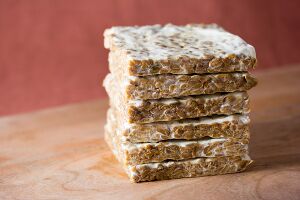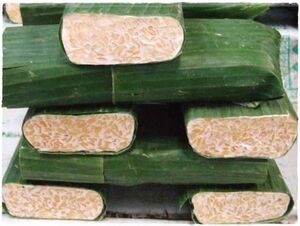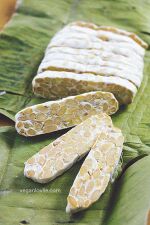Course:FNH200/Projects/2023/Tempeh and Fermentation
Introduction

Tempeh, a beloved traditional food with Indonesian origins, has emerged as a culinary delight celebrated worldwide. Made from fermented soybeans, this wholesome and protein-rich product has been a staple in Indonesian cuisine for centuries. The process of crafting tempeh involves binding soybeans into a firm cake-like structure, thanks to the natural action of beneficial mould known as Rhizopus oligosporus. As the fermentation process unfolds, a unique nutty flavour develops, setting tempeh apart from its soy-based counterparts. With its rich history, exceptional taste, and versatile culinary applications, tempeh has captivated the palates of individuals seeking a plant-based, nutritious alternative, and continues to entice food enthusiasts with its authentic charm[1].
Pictures
-
Fermented Tempeh On Banana Leaf
-
Cooked Tempeh
-
Mendoan Tempeh
-
Cooked Marinated Tempeh
How Tempeh Is Made
Stages

The production of tempeh consists of three main stages of soaking, fermentation and incubation. In the earliest stages of production, whole soybeans are gathered to be soaked overnight which allow the ingredients to soften its texture and further be dehulled when boiled for 30 minutes. Upon boiling, the beans goes through a fermentation process by being spread out on a tray for inoculation with the spores of a fungus called Rhizopus oligosporus. This fermentation process usually last up to 48 hours (2 days) where the soybeans slowly develops a whitish colour, firm texture and nutty flavour, forming what is known as tempeh[2].
Stage 1: Preparing the Soybeans
The production of tempeh starts off by soaking whole soybeans overnight (at least 6-8 hours) at a water temperature of 25°C. Newer and modern methods of tempeh production also adds vinegar to enhance sensory attributes of the tempeh such as a golden-brown colour, salty flavour and ammonia smell. Ultimately, the soaking process allows to not only cleanse the soybeans, but most importantly rehydrate it in order to develop a softer texture that makes dehulling easier. While the dehulling process is optional for tempeh production, many traditional production methods in Indonesia chooses to remove the soybean skin to further create a softer tempeh texture in expense of the nutritional value the skins could have offered when kept intact. Upon soaking and dehulling, the soybeans are cooked in a boiling pot for 30 minutes at general water boiling point of 100°C. The cooking process further improve the soybeans digestibility in which it becomes tender, while removing potential harmful microorganisms sensitive to heat. Finally, the soybeans are then cooled down to below 35°C which allows key microorganisms for making tempeh to grow during the fermentation process.
Stage 2: Fermentation
Upon drying and cooking, the soybean undergoes fermentation by inoculation with the spores of a filamentous fungus named Rhizopus oligosporus. In this case, the thin layers soybeans are fermented for 24-36 hours at a temperature of 30°C to inflict spore germination and growth of mould from Rhizopus called Mycelium. The dense root-shaped mould plays a key role in influencing the sensory attributes of tempeh especially by binding the soybeans together into a compact solid mass. Moreover, enzymes synthesised by Mycelium may hydrolise the soybean constituents to release bioactive peptides and eliminates anti-nutritional components.
During the fermentation process, optimal fermentation time, temperature, oxygen and pH level is essential to support the abundant growth of Mycelium. More specifically, pH levels are kept between 3-5 to further support the growth of Mycelium and restrict growth of microorganisms causing spoilage. To maintain the pH levels, mild acidulant such as vinegar and lactic acid can be added. Moreover, oxygen level are also kept in lower levels to prevent the growth of undesired microorganisms.
Science behind the Fermentation
Before the process of inoculation, the soybeans go through a natural fermentation without the addition of a started culture to reduce the acidity of the foods below 4.6, this is done by first soaking the soybeans in water and going through lactic acid bacteria fermentation which happens at room temperature to less than a day[3].
Tempeh is held by the mycelium as a result of the inoculation of Rhizopus oligosporus to the soybeans. The enzymatic activities of the microorganisms lead to an alteration of the nutritional parameters of the soybean. There are anti-nutritive compounds in soybeans that are partly degraded by the Rhizopus bacteria, including are trypsin inhibitors and potential allergens through hydrolization by peptidases. Tempeh is generally fermented in places like plastic beds or bags that are perforated or banana leaves which is how it is traditionally done. This ensures sufficient aeration for 1-2 days at a temperature range of 25-37°C[4]. After this 2nd fermentation, the mycelium from the Rhizopus covers and binds the beans them together into a solid, the mold on the tempeh releases ammonia which forms an alkaline fermentation that allows the tempeh to raise its pH to between 6.8 and 8.0[3].
Stage 3: Incubation
After the inoculation process has ended the tempeh undergoes an incubation period which lasts at least 20 hours as 32°C. The incubation period allows the tempeh to develop and grow mycelium all around its surface leaving little to no sporulation[5]. Although incubation periods vary in temperature and length of fermentation depending on recipe used, temperature and humidity must be controlled to optimize fermentation and prevent spoilage and growth of spoilage organisms[6].
Packaging and Quality Maintenance
Packaging
Tempeh can be seen in two types of packaging: wrapped with a banana leaf or wrapped airtight in plastic.

Option 1: Banana Leaves
Banana leaves are the traditional tempeh packaging, mainly used in Indonesia, where tempeh originated from. The main reason why banana leaves are used to wrap tempeh is to add flavour. Locals like to say it gives the tempeh "better taste", as it also gives the tempeh a "delicious smell"[7]. This flavour comes from the natural wax coating on the leaves. Other than that banana leaves contain polyphenols which can act as antioxidants, giving them an extra advantage[8]. Banana leaves contain polyphenol oxidase (a familiar term we learned in class). We learned that this enzyme catalyses enzymatic browning. Although it may contribute to the browning of the leaves, polyphenol oxidase actually has some health benefits. Many research has shown that it can help treat Parkinson's disease, by countering neuro-degeneration[9].
However, using banana leaves as tempeh packaging also has its disadvantages. It is opens up a higher chance of contamination. As these leaves are harvested, they need to be thoroughly cleaned and sterilized to make sure they are not carrying any microorganisms that could potentially contaminate the tempeh. Additionally, once the leaves are used to wrap the tempeh, they are not sealed. They are either tied with a string, clipped with a toothpick, or even left with some areas open. Even worse, banana leaves are easily torn. This leaves the tempeh open to oxygen and various aerobic bad and ugly microorganisms, which could lead to oxidation and food degeneration.

Option 2: Plastic Wrapping
Plastic wrapping is a much more common option for tempeh packaging. The tempeh is packaged in polyethylene plastic, which is the most widely used plastic for food packaging. It is much more globally available compared to banana leaves, which are mainly found in Southeast Asia. An advantage plastic packaging has, other than the availability, is safety and shelf life. Unlike banana leaves, plastic packaging is sealed airtight, which lowers the chance of contamination from microorganisms, and unfavorable chemical and enzymatic reactions. Additionally, using plastic means that modified atmospheric packaging is possible. This then leads to longer shelf life, compared to banana leaves, where modified atmospheric packaging is not possible. Polyethylene plastic is widely used because of its many benefits, including sterility, light-weight capability, versatility for various sizes, and most importantly, puncture resistance[10]. This definitely gives polyethylene plastic packaging another advantage over banana leaves, since unlike leaves, they are not easily torn or punctured, further protecting the food.
Storage
Although fresh uncooked tempeh goes through a lot of steps in production, it is still considered a perishable food. It has to be stored in a chill temperature, either refrigerated or frozen. Tempeh stored in refrigerators and freezers need to be sealed airtight to prevent it from drying. Therefore, tempeh wrapped in banana leaves cannot be refrigerated and hence will have a very short shelf life. Many sources suggest that plastic-wrapped uncooked tempeh can have a shelf life of up to 10 days in the refrigerator and only around 3 days in room temperature. If kept sealed and unopened in the freezer, it could last up to 6 months. However, according to the BC Centre for Disease Control, storage dates can vary depending on whether or not the tempeh goes on to be pasteurized or not after the initial fermentation. Some manufacturers may choose to blanch pasteurize their tempe to allow for an extended storage period by up to two to three weeks[3]. It is best to store tempeh in the refrigerator to help maintain its quality and to be protected from cross-contamination. Prolonged storage of tempeh can result in undesirable odors forming due to the increase in ammonia, black sports from the Rhizopus sporulating, or the possible growths of harmful pathogenic bacteria which will ultimately inhibit the Rhizopus culture.
Health Benefits & Risks
Health Benefits
Commonly regarded as a superfood, tempeh contains both high nutritional contents as well as as bioactive compounds. This is largely attributed to the antioxidant properties soybeans can hold, which can protect human cells from oxidative stress linked to aging and chronic diseases. This is due to the fermentation process in which the enzymes presents secreted by the mould create free isoflavones that are stronger antioxidants and are absorbed by the intestine better[11]. Studies have shown that that the consumption of tempeh have seen to improve gut health as well as the immune system. Due to its antioxidant properties, it has also reported to reduce blood pressure and improve blood lipid profile in rats fed with high lipid diets as well as help protect against liver damage caused by alcohol[12].
Health Risks
Tempeh holds health risks for people with soy allergies and thyroid disorders. Since tempeh is created from soybeans, people with soy allergies should stay clear of them. Soy is also known to affect how thyroid in the human body works[13], especially for people with iodine deficiencies. This can lead to hyperthyroidism, a disease that slows down a person's metabolism[14].
Furthermore, there are certain biological and chemical toxin hazards that are associated with tempeh products, in situations where the microbiological quality of the tempe sold exceeded standard bacterial counts. Fermented soybeans and its other forms are also susceptible to a bacteria called B. cereus[3].
Potential Exam Question
Answer: Pasteurization inactivates spoilage-causing microorganisms. We learned about pasteurization in lesson 6, as a method used for thermal preservation. We learned that pasteurization is able to inactivate spoilage-causing microorganisms, but not able to kill disease-causing microorganisms. This could only be achieved with commercial sterilization or ultra-high temperature processing, therefore the first choice is wrong. We also learned that the process of pasteurization involves high heat for only a short period of time, around 15 seconds, which is not enough time to break down proteins. Furthermore, protein breakdown of soybeans are not a part of the tempeh production process, so the second choice is wrong. Lastly, there is a reason why only some manufacturers choose to pasteurize their tempeh. The pasteurization process can negatively affect flavour and texture. So it does not enhance the nutty taste and it can alter texture and therefore the last choice is wrong. The ability of pasteurization to inactivate spoilage-causing microorganisms leads to an extended shelf life for tempeh.
List of Potential Questions about Tempeh and Fermentation (previous assignment)
- What is unique about tempeh?
- How is the process of making tempeh different from other fermentation techniques?
- What is the origin of tempeh?
- How does fungus carry out fermentation?
- What kinds of fungus can carry out fermentation?
- What is Rhizopus oligosporus?
- How are the processes between tempeh and tofu different?
- How is tempeh traditionally made?
- How is tempeh made in present day?
- Why is tempeh often wrapped in banana leaves?
References
- ↑ "Tempeh".
- ↑ Shurtleff, William (1979). Tempeh Production. The Book of Tempeh: Volume 2. A Craft and Technical Manual. New-Age Foods Study Center. ISBN 0933332025.
- ↑ 3.0 3.1 3.2 3.3 "Tempe (tempeh) fermentation" (PDF). BC Centre for Disease Control.
- ↑ Maheshwari, Garima (2021). "Role of Fungi in Feremented Foods". Encyclopedia of Mycology – via ScienceDirect.
- ↑ http://www.bccdc.ca/resource-gallery/Documents/Educational%20Materials/EH/FPS/Food/TempehFermentation.pdf
- ↑ Uraz, T (2014). "STARTER CULTURES | Molds Employed in Food Processing". Encyclopedia of Food Microbiology.
- ↑ "Which One Is Better : Tempeh Wrapped In Leaves Or In Plastics?".
- ↑ "Top 4 Benefits Of Eating Off A Banana Leaf".
- ↑ "Potential therapeutic effects of polyphenols in Parkinson's disease".
- ↑ "THE ROLE OF POLYETHYLENE PACKAGING IN CONSUMER HEALTH AND HYGIENE".
- ↑ Romulo, Andreas (December 2021). "Tempe: A traditional fermented food of Indonesia and its health benefits". International Journal of Gastronomy and Food Science. 26 – via ScienceDirect.
- ↑ "Fungal Fermented Foods".
- ↑ "The Health Benefits of Tempeh".
- ↑ "Is Soy Bad for Your Thyroid?".



